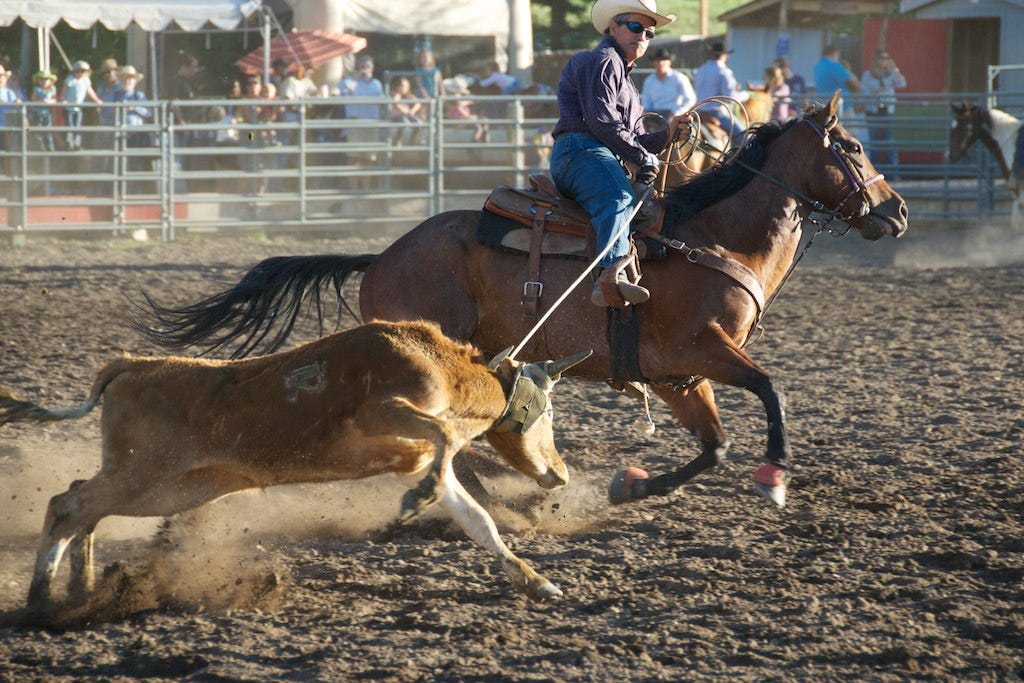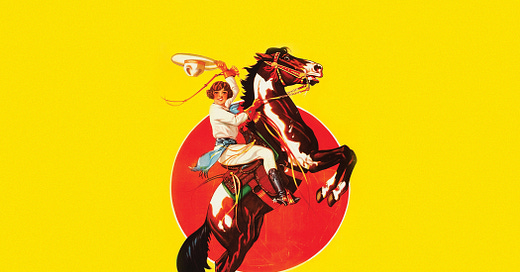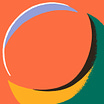The Glories of the American Rodeo
A grand cultural institution that retains the power to thrill and delight.
THE DAYS ARE STILL HOT AND LONG, but an autumn breeze is creeping into the nights. In the fields, garbanzos, lentils, and hay have all ripened to a uniform straw color. Soon they will be harvested, and the stubble and bare soil left to winter’s ravages will look ominous, as in fact they are. But for now, everything is fullness, completion, the slow and heavy part of the year. Smoke from wildfires makes the air hazy. It’s rodeo season.
There are all different types of rodeo: informal, unpublicized ranch rodeos organized by working ranch hands; amateur, collegiate, and semi-pro events; and pro events where entrants compete for money prizes. Among these are the Indian National Finals Rodeo and the Professional Bull Riders league and the Professional Rodeo Cowboys Association (PRCA). The PRCA system is a bit complicated: As I understand it, your total prize winnings in any contest in the country count towards a shot at the National Finals Rodeo, but the country is also divided up into circuits. Competing in your home circuit gives you a shot at the National Circuit Finals Rodeo. Rodeo cowboys who don’t win money stand to lose their entry fee, their travel expenses, and maybe their spinal integrity. The big money prizes are a big draw, while working your circuit can represent a more modest bet. The smaller, less munificent roundups often have the relaxed charm of minor league baseball: smaller cities, high commitment to having a good time, players whose non-stardom lends a kind of purity to their love of the game—but still, with the possibility of glory always hanging in the air.

The first consideration on rodeo day is how to smuggle in alcohol. Among all the booths and hawkers surrounding the arena, there are always a few licensed beer trailers. But there are the usual complications. You have to get a wristband and buy tokens at an entirely separate tent. The token denominations never exactly match the price of beer, so that one way or another, you are always leaving money on the table. There is a limit to how many beers you can take back to your seat with you. There are always lines. These are doubtless deliberate speed bumps placed in the way of consumption. Plenty of people are happy to power through them (my friend once saw a man vomit directly and perfectly into the upturned ten gallon hat of the man sitting on the bleacher below him, in the tidiest piece of public drunkenness she ever witnessed.) But ultimately I can only stomach buying so many overpriced Coors Banquets, and so the smuggling issue arises. Here is a tip: The man in wraparound sunglasses taking tickets might search your bag for a gun or a flask. He will rarely search your boot or your décolletage.
As you walk up through the fields to where the floodlights gleam, you pass an old man who came on horseback, a big silver buckle on his belt and a feather in his hat and a (surely deservedly) self-satisfied grin on his face. You pass wranglers and coordinators of various kinds leading and lugging horses and cattle from where they should not be to where they should be. As you approach the chutes, the smell of animal sweat and straw and good clean cattle dung intensifies and dominates the normal carnival smells. Something clangs; something is moving in the dimness. I always pause for a minute. It seems impossible that a bull should be in that narrow space, that all his rippling, archaic mass should be so casually separated from the unconcerned human world of asphalt paving and plastic port-a-potties by a flimsy metal gate. A bull in a field is one thing. A bull under the bleachers is another.
Up on the metal risers, wedged comfortably between flannel-shirted families, my excitement starts mounting. It’s the excitement of being in any large group of people waiting to see something happen on a late-summer night, but it’s also the change in the air, the darkening Idaho sky rolling out like thunder over the quiet fields, the lights designating the arena’s floor as the temporary center of the earth—a place where, in a few moments, a tremendous charge of action compressed into a few brief seconds will irrupt.
But first, it’s time to stand for the national anthem. The announcer’s voice booms out from the box in its carnival barker cadences, with mention of members of the military here today and far away, and due remembrance of 9/11; the rodeo queen circles the arena at a gallop, holding the flag aloft. Then it’s a word of thanks to our sponsors: the agricultural cooperative, the credit union, the casino. Nez Perce riders, splendid in regalia on splendid Appaloosas, take their galloping turn. Then come the rodeo sweethearts (former rodeo princesses and queens) and the rodeo court (current rodeo princesses and queen). They come one after another at seeming breakneck speed, flags in one hand, reins in the other, hair flying, chaps and hats and fitted fringed shirts all flashing sequins, until their circles make an endless stream that gives way to a criss-crossing choreography. They are beautiful with the impersonal beauty of the ceremonially adorned; they make your heart swell to watch them. The rodeo is above all things a great show.
The show is not merely enacted, but assumed—donned with the bright blue spangled chaps, the clown’s face paint, the traditional regalia, the parade floats that open the rodeo, the old men’s denim and silver Sunday best. This visual culture, overwhelming purely as an array of colors and materials, is also a textual culture. The spangled chaps are embellished with names and dates, the parade floats and flags are emblazoned with the names of civic institutions, and the arena is hung with banners bearing the names of local businesses. The belt buckles cowboys win are engraved with a record that will sit proudly above their hips. These scraps of writing are a door through which something from ordinary life is carried into the magnificent caricature of it that is rodeo time, and something of the gaudiness is carried back out.
THE FAMOUS BUCKING BRONCO is not the only rodeo event. There are varieties of calf roping—team, breakaway, and tie-down—there is steer wrestling, there is barrel racing, there are the bulls. My favorite are the barrel racers. Barrel racing is a women’s sport, and as the name suggests, the deceptively simple goal is to maneuver your horse around a series of triangulated barrels in as little time as possible, without knocking them over or otherwise compromising the requisite clover leaf pattern. In practice, this means a series of momentum-building straight-line rides alternating abruptly with extremely tight twists and turns. The young women take their turn one by one, to the sound of thundering rock anthems and the announcer booming out their names, hometowns, horses, and world standings. They gallop for the barrels, spurring their horses faster and faster. At the first barrel, they slow down just enough to keep the motion smooth and unbroken, wrapping themselves around the edge of the barrel without actually touching it. To accomplish this tight turn without losing momentum, the horses take the curve at a perilous-looking leaning angle, before hurtling on to the next one and finally racing like lightning back to the finish line. Muscle memory must be perfect, timing exact, trust between horse and rider implicit and communicative. The barrel racer must not only be in complete control of her horse, she must keep her body attuned to its movements, shifting to balance and follow them. The powerful equilibrium of those leaning curves, a whisper and a breeze from disaster, permits nothing less.

I could watch the barrel racers all day, but each event has its own graceful physical lyricism—the lariat slicing the air, the still-moving dismounts, the compact efficiency of the tie-down movements—except for mutton busting. In mutton busting, well-padded kindergarteners take a firm hold on the wooly backs of sheep and try to hang on for dear life as the ewes, unexpectedly saddled with another’s lamb, tear around the arena. It is wholly ridiculous, but the little tykes climb up from the dust with as much dignity as they can muster, the crowd cheering, their mothers smiling and waving at them in case the combination of floodlights, failure, and physical shock proves too much for their stiff upper lips.
Failure is a constant at the rodeo. It is not like team sports, where sustained play at a high level means the moments of breakthrough are often the game-winning exception. You’ve got just a few seconds at your shot, and your opponent is an animal. The most quietly dramatic moments, to me, are in breakaway roping: barely out the gate, a minuscule falseness, a momentary misjudgement, and the calf is off and running while your loop falls on air. You’re over before you’ve begun.
Failure is just failure, though. The real worry is the crunch. There is no rodeo event that could be made completely safe, but the crunch belongs especially to the bareback broncs, the saddle broncs, and most of all, the bulls. Someone gets bucked off at the wrong angle; someone doesn’t get up when he should. The ambulance arrives. I often think there should be a special variant on the tie-down calf-roping event for mothers whose sons express an interest in roughstock riding.
The bullfighters are the ones who keep this possibility to some degree at bay. They are deceptively pedestrian amid all the rodeo pageantry, in plain cowboy hats, cleats and high socks, John Fetterman shorts, and loose-fitting athletic shirts. But their role in the bull rides is a dangerous game of keepaway—dancing just out of reach of the heaving duo, ready to intervene if something goes south, with no guarantees that they will not be that something. As soon as the interminable eight seconds are over, they rush in to draw the bull’s attention to themselves and allow the rider to roll off without being trampled or gored. I often find myself watching the bullfighters more than the riders they protect.
The chief of the bullfighters is the rodeo clown. He wears a painted face with his bullfighter’s uniform, and hunkers down in a protective rubber barrel when the bulls become irascible. Carrying the barrel around him, he looks like a 1930s cartoon of a hobo. Peeping out with his hat just above the rim, or standing with only his torso visible, he looks like some kind of gnome sprung from his walnut-shell home, as archaic in his own way as the bull. When he is not helping distract or hiding from the bulls, the rodeo clown’s job is to entertain the crowd between acts, carrying on a running patter with the announcer, strutting and darting around the arena in a sometimes physically frenetic, sometimes elaborately planned and propped, and usually very broad comedy routine. He is important. He maintains the rodeo not as a series of historically derived athletic events, but as a show. No roundup is complete without him.
At some point during one of his routines, I’ll get up and make my way down to the beer trailer. It feels miserly and un-civic not to buy at least one drink from the official vendor. People are selling elephant ears and beaded earrings, t-shirts and pinwheels and carved miscellania. Children are escaping their parents, long-haired teenagers from the reservation are goofing around, girls in denim cutoffs and cowboy boots are standing in gaggles. People in line are visiting with friends from the next town over. The moon is up, the air is warm and heady with the last remnants of summer, and everyone is having a good time. Later, there will be a concert, and dancing. Inevitably someone will disgrace themselves a little. I will dance, and go home, and rodeo time and summer will be over. But next year, they’ll be back.






